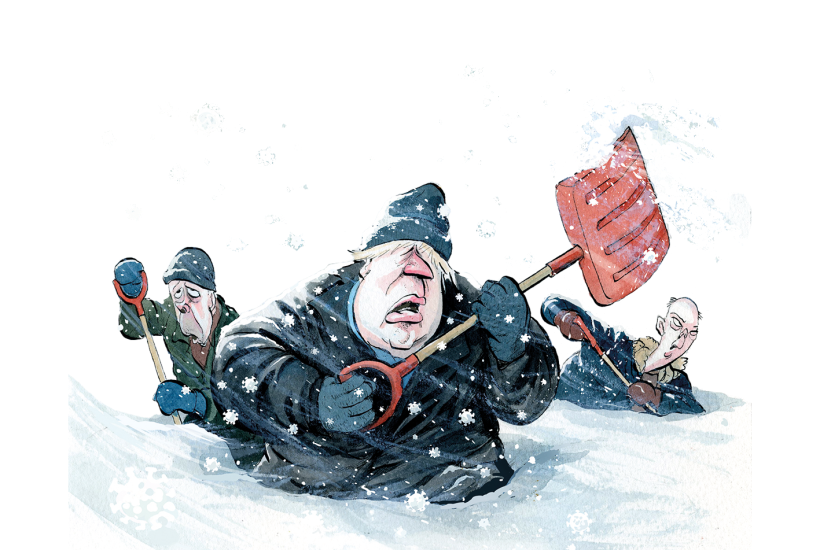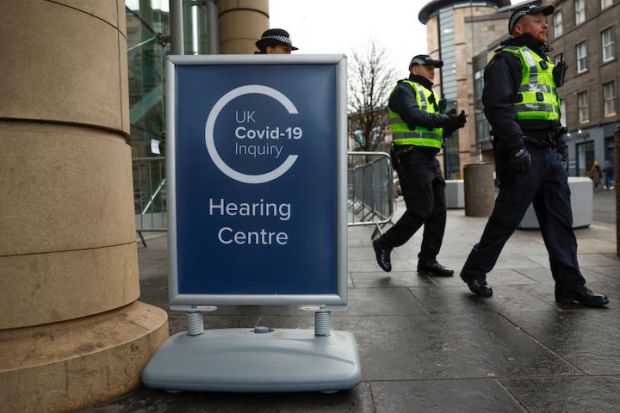We have just seen how much the Prime Minister’s view of the virus has changed, and how quickly. Just ten days ago, he was attacking circuit-breaker lockdowns for the “psychological and emotional” damage they inflict: the effect on mental health as well as the economy. Now, the Prime Minister talks not about the evils of lockdown, but the evils of failing to lock down: an NHS overwhelmed, ‘doctors and nurses forced to choose between saving Covid patients and non-Covid patients.’ He could well be right, but a U-turn of this magnitude needs some explaining.
As soon as he started his statement, he turned to the graphs on which his case hangs. Sir Patrick Vallance, the Chief Scientific Officer, ran through them: the same ones leaked to the BBC a few hours earlier. Some of them showing daily deaths surging to 6,000 – six times the first peak. If this is even remotely plausible, drastic action is understandable. Here it is:-

There’s no mention of ‘worst-case’ scenarios: these are billed only as ‘winter scenarios’. But who drew them up? What are the assumptions? The leak this morning told us who did the modelling: Cambridge, Imperial, etc. These studies ought to be published, together with the assumptions behind them – to help understand how we get from the data we’ve seen in recent weeks – which suggested a virus under control – to the scenarios shown to us now.
The last time we had a gloomy scenario outlined to us in a press conference was 21 Sep when Vallance & Whitty gave a projection of 50,000 reported daily infections by mid-October. Those who dismissed this as fanciful were proved right fairly quickly – even now, at the end of the month, daily infections are barely half that figure. Yet somehow, from an infections trajectory growing nowhere near as fast as that outlined by Vallance and Whitty, we now see projections of a Covid tsunami that dwarfs even than their own worst-case scenario. How?
This raises big questions about what we know about the virus – and what changed. The government’s worst-case scenario of 30 July had deaths maxing out at 800 a day. This now looks far lower than any of the new studies commissioned. The Sage worst-case scenario has never been published officially (which is why The Spectator made it public a few days ago). Here’s the deaths it envisaged:-
Why have the forecasts become so much worse? Is it because the virus is deadlier than we had thought, or that the current Covid measures are less effective than we thought? How did we get to a position where the consensus was the virus had been (effectively) tamed, to a situation where we see a monster threatening to crush the NHS unless we enforce a national lockdown – and close the pubs, churches and bookshops forthwith? Are there similar studies in Europe, with massive upgrades pointing to a Covid tsunami on a similar scale? Or do we feel there’s something particular to Britain that means, even after the care we were taking, that the second wave could rise four times as high as the first? Somewhere along the way, assumptions have changed – a lot. We have not yet been told which ones, or why.
Then the hospital numbers: this time, not a range of outside forecasts but the government’s central forecast, showing far more hospitalisations than first time around.

Again, what are the assumptions used to make the above chart? And how did they change so quickly? The Sage worst-case scenario we published was dated 30 July – and it involved it maxing out at just over 3,000 admissions per day. Now the central estimate easily smashes through 4,000 – it’s not even a peak – rising perhaps as high as 8,000. What changed to move that picture so dramatically?
The first time, the virus spread before we knew what was going on: we lived, mixed, rubbed up together as normal until mid-March: by lockdown, infection levels were probably falling. And it was still, then, a quarter of the size now that we’re distancing, wearing masks, not singing in church, not going to each other’s houses? None of that is enough to stop it coming back four times the size? Perhaps not, but this is point that will puzzle people and needs more elaboration.
Also: why, if this was always on the cards, did we not use this summer to scale up the NHS? We’re now back to ‘protect the NHS’ as a mantra: a phrase deeply controversial amongst doctors because it discourages the sick from seeking help. You’ll note the absence of any modelling on the extra cancer deaths, extra deaths from Alzheimer’s and the cost of the new lockdown on a country where almost half of the over-70s live alone.
When The Spectator published the leaked July 30 Sage RWC analysis earlier this week, we ran the whole document with every assumption in it. Some of them are quite important: for example, that the infection fatality ratio is 0.7 per cent. That’s pretty important because it’s a death rate more than twice as high as the current consensus (0.3 per cent). Sage seemed to be pushing the ‘worst case’ to the max, yet its death figures are dwarfed by what we now see. Again: why?
Finally, the above graphs point to a peak in December or January – so do we really think restrictions will be relaxed in either of those months? So there is a very important story to tell here. That’s why No. 10 ought to publish the new studies and assumptions, and tell us what has changed so much.
Got something to add? Join the discussion and comment below.
Get 10 issues for just $10
Subscribe to The Spectator Australia today for the next 10 magazine issues, plus full online access, for just $10.




















Comments
Don't miss out
Join the conversation with other Spectator Australia readers. Subscribe to leave a comment.
SUBSCRIBEAlready a subscriber? Log in